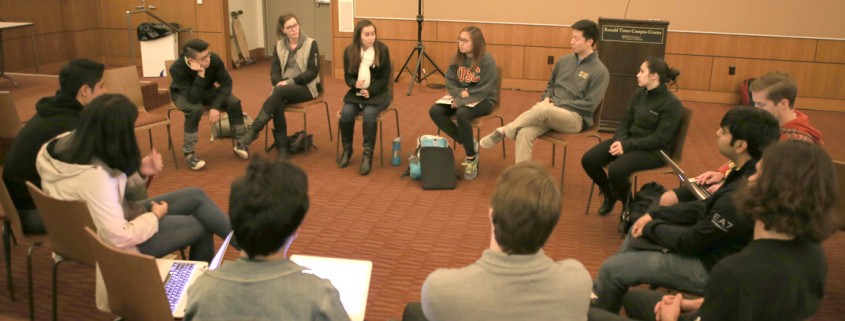Political Student Assembly discusses Common Core
The USC Political Student Assembly hosted an open discussion about education policy in the United States on Monday as part of USC Academic Culture Assembly’s EdMonth. The fuel for the discussion was the Common Core State Standards initiative, a system designed to promote consistent and quality education across state lines through standardized goals and expectations for students in English language arts, literacy and mathematics.
“Instead of whatever standardized tests you had previously, this is a new way of standardized tests for grade schools. It’s a new way of teaching, a new way of evaluating student’s progress throughout grade school,” said Jenny Di, director of the Political Student Assembly.
Common Core has sparked a great deal of controversy. Some say that the standards could provide a stable nationwide benchmark that will help the United States compete with international education standards, whereas others say that the initiative imposes too many regulations and restricts education professionals from customizing their curriculums in meaningful ways.
Di and Luis Vidalon-Suzuki, assistant director of the Academic Culture Assembly, moderated the discussion. The goal of the discussion was both to inform students of and to evaluate Common Core as a new system for assessing the nation’s educational system.
“There’s no real objective about which side is more right, it’s just a roundtable discussion on the pros and cons of the system, the opinions of students, and possibly better solutions or the benefits of Common Core in our education system,” Vidalon-Suzuki said.
The roundtable discussions found positive and negatives aspects of Common Core.
Some people raised the concern that Common Core would not allow teachers enough control over their curriculum at the local level. Other people criticized the English language arts and literacy section for being too rigid so that it might limit students’ creativity and free-thinking.
Many agreed that the initiative would be a very useful way to maintain consistent, quality standards for education nationwide, arguing that this consistency would have a very positive outcome for students.
“One benefit is that if a student moves from one state to another, then the curriculum will be more or less the same because they have the same Common Core standards,” Vidalon-Suzuki said.
Many comments addressed the mathematics portion of the Common Core standards, as it creates an entirely new model for teaching basic addition, subtraction, multiplication and division with an emphasis on grasping the concepts underlying these operations rather than repeating the same techniques.
Take for example the mathematics section, which teaches students to approach subtraction by visualizing the distance between two numbers. In addition to the traditional borrowing method, the Common Core incorporates a number line and hierarchy method to provide children ways to learn a fundamental operation.
Policy makers have recently been challenged to improve education in the United States to meet international standards.
“One big problem that we have is that we focus more on top down policy when we should be focusing on students and teachers and their viewpoints, because nobody knows what’s best for a community than the community themselves,” Vidalon-Suzuki said. “What we see right now is that we have policy makers and people who maybe have never attended a public school making these decisions, and they don’t have a direct understanding of what impact their decisions have.”

